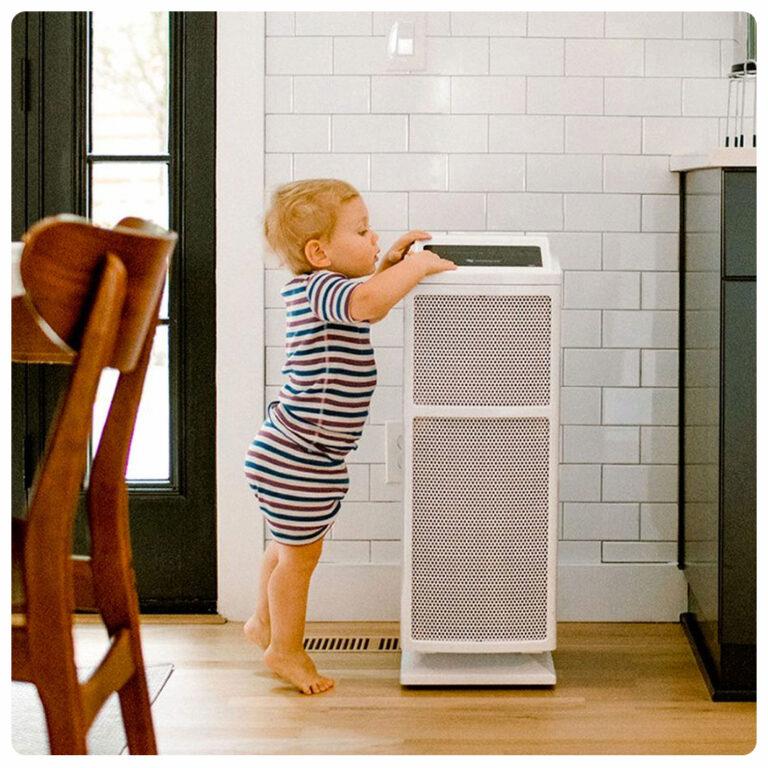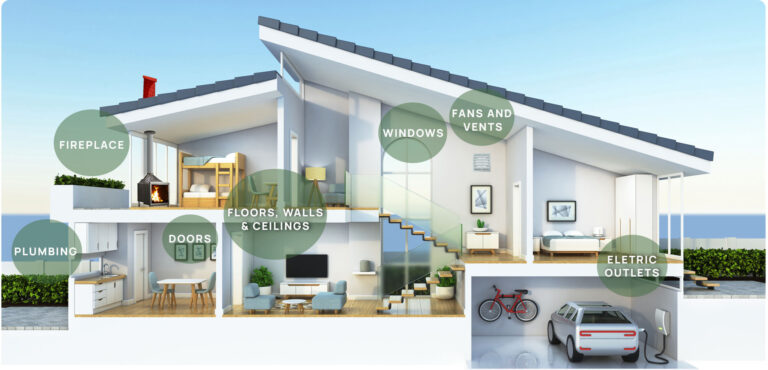Table of Contents
- Why invest in the IAQ of your home?
- What can air purifiers protect your home from?
- Quiet enough for nap time.
- Outside pollutant sources can enter indoors.
- voc">VOCs in the home & the harm they bring.
Why invest in the IAQ of your home?
A home is a place of comfort, where you can unwind, raise a family, or even work remotely. Many people describe their home as the place where they feel most safe and secure. With families spending more and more time in their home, they are considering safety and comfort measures that will make their space "near-perfect." One thing that continues to surface in mainstream news, on social media, and by experts is the value of improving air quality by adding an air purifier at home.
Air purifiers are designed to neutralize particles, volatile organic compounds (VOCs), and microorganisms. Whether you're dealing with wildfire smoke or allergies, it's important to learn about how a product will help. When adding an air purifier at home, be sure to understand the capabilities and performance of the unit - specifically how efficient the unit is at removing the particle of concern.
With a device like our Ultrafine 468, the air is cleaner, the kids aren't sick as often, and productivity increases when working remotely. Our engineers designed the Ultrafine to be the leading air purifier at home - it is easy to maintain, performs at the highest level, and has a quick and easy filter change. Different from others, we individually test each unit to exceed the HEPA standard before it leaves our warehouse. And of course, it's lightweight and portable, so you can move it wherever you need it most - from the living room to the kitchen, to the bedroom at your convenience.
What can air purifiers protect your home from?
 Pollen particles sized at 10µ-70µ
Pollen particles sized at 10µ-70µ
 Mold spores sized at 1µ-40µ
Mold spores sized at 1µ-40µ
 Pet hair sized at 2.5µ-10µ
Pet hair sized at 2.5µ-10µ
 Bacteria as small as 0.5µ
Bacteria as small as 0.5µ
 Viruses sizing around 0.1µ
Viruses sizing around 0.1µ

Quiet enough for a conference call, a dinner party, and most importantly, nap time.
Nap time is a cherished time for parents, hoping they can catch up on some sleep too! Placing a quiet air purifier at home, with just a soft hum, ensures a baby can nap uninterrupted. Working from home or hosting an intimate dinner party? No problem. When shopping for an air purifier at home - it's important to look at the sound or dB level it emits. Luckily, our Ultrafine 468 is relatively quiet, with the highest CFM per decibel level of noise in its category.
Our lungs work day and night to pump oxygen to our bloodstream, which then provides that oxygen to our tissues and organs enabling us to function. As millions of people are now permanently working remotely from their own homes, they are spending many more hours breathing indoors. On average, people spend 90% of their day indoors, while we breathe in and out about 22,000 times a day. So, what if you have poor air quality in your home?
Most people are aware of outdoor air pollution and ways to avoid it, but with the increase in time spent indoors, we need to take a better look at the impact of indoor air quality. The recent wildfires of the past summer have shown that indoor air quality is not something we can take for granted. Outdoor air can enter the home in many different ways other than windows and doors.

Outside pollutant sources can enter indoors.
Whether you live near a city, a wildfire region, or close to an industrial factory, pollutants from these sources can enter your home's air. There are various ways air can enter a building, whether it is let in through an open window, or seeps through the electric outlets. Outdoor air enters and leaves a building by infiltration, natural ventilation, and mechanical ventilation. But, having an air purifier at home can help.
- Infiltration: Travels into the building through openings, cracks, and joints in the walls, floors, windows and doors, and ceilings
- Natural Ventilation: Air enters the building through an open window or door
- Mechanical Ventilation: The process in which outdoor vented fans circulate air through ducts
Being aware of products within the household that could potentially give off pollutants is essential to assessing the air quality in your home. The main causes of indoor air pollution occur from the release of gasses or particles. According to the World Health Organization, or WHO, 3.8 million people die a year from household exposure to smoke from dirty cookstoves and fuels. When it comes to fuel sources within the home, proper ventilation is necessary. Signs that can indicate your home may not have enough ventilation include:
- Condensation on windows or walls
- Stuffy air
- Dirty HVAC equipment
The main causes of indoor air pollution come from the release of gases or particles. These sources can be coming from indoors, such as the kitchen stove releasing fumes, or from outdoors, such as pesticides sprayed on crops. High temperatures and humidity levels may increase the concentration of some pollutants.
According to Study Finds, the average U.S. home air quality may be comparable to a "polluted major city." Normal household activities, such as cooking and cleaning can lead to toxins and pollutants being released into the air. Without proper ventilation, these harmful particles remain in the air and are potentially breathed in by the building occupants.
Researchers from the University of Colorado Boulder did a study within a 1,200 sq foot manufactured home in Austin, Texas. They attempted to maintain a "normal" lifestyle, by cooking and cleaning regularly. After the study, they found the indoor air quality so poor, that they had to adjust all of their sensitive instruments.
VOCs in the home & the harm they bring.
Volatile organic compounds, or VOCs, are chemicals that many are human-made and can come from furniture, chemical cleaners, and paints within the home, resulting in concentrations up to ten times higher indoors. Studies have found that levels of several organics average 2 to 5 times higher indoors than outdoors and once these chemicals are in our homes, they are released into the air we breathe.
VOCs can cause serious health effects, both short-term and long-term including liver, kidney, and central nervous system damage. Our best-in-class VOC filters eliminate cooking fumes and cleaning chemicals from the air, before and after the main filter. If the researchers had an Ultrafine 468 within their 1,2000 sq. foot home, they wouldn't have had nearly the amount of particles in the air.
Air purifiers are not created equally.
There are many types and sizes of air cleaners on the market, ranging from table-top models to sophisticated whole-house systems. When shopping for an air cleaner it's important to look at total system efficiency, VOC filtration, and the number of square feet it can appropriately service. It's noteworthy to remember that not all air purifiers are created equally and some are more effective than others.

The Ultrafine 468 has a pre-filter featuring a special carbon material that pre-absorbs VOCs and harmful chemicals. Up next within the Ultrafine 468 filtration system is the VOC post-filter, which absorbs VOCs such as formaldehyde, benzene, and toluene. Behind the post-filter is another layer of protection, the main filter, which is integrated with DFS technology to capture particles down to 0.007µ. This air purifier holds rigorous standards such as CARB, Intertek Zero Ozone, and EN 1822.
Another important factor in determining the effectiveness of an air cleaner is the strength of the pollutant source. Table-top air cleaners, in particular, may not remove satisfactory amounts of pollutants from household sources. People with a sensitivity to pollutants may find that air cleaners are helpful only in conjunction with concerted efforts to remove the source. Invest in an Ultrafine 468 air purifier and discover what Intellipure® can do for you.
High-Performance Portable Air Purifiers
Explore plug-and-play solutions for your space that meet or exceed the HEPA standard.
-
Sale!

Compact Air Purifier
Up to 500 sq ft
Original price was: $299.00.$159.00Current price is: $159.00.
Add to cart
-
Sale!

Ultrafine 468 Air Purifier – White
Up to 1,200 sq ft
Original price was: $999.00.$449.00Current price is: $449.00.
Add to cart
-
Sale!

Ultrafine 468 Air Purifier - Black
Up to 1,200 sq ft
Original price was: $999.00.$499.00Current price is: $499.00.
Add to cart
Intellipure®
We’re reimagining the world as a better, safer place with innovative air purification technologies. Our solutions are engineered in the USA and trusted in nearly every industry. To find out more about the latest in clean air take a look at the Intellipure lineup and follow us on Instagram at @Intellipure.



